Menu
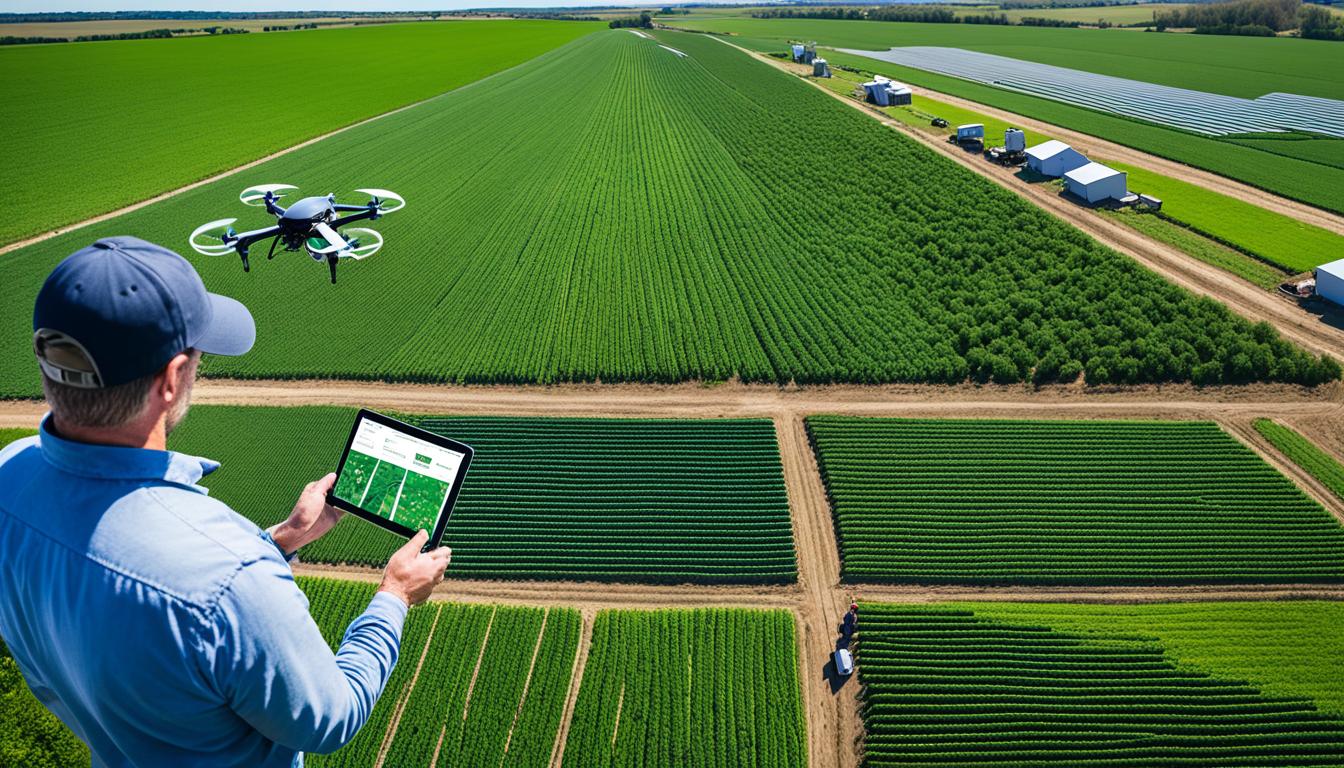
Did you ever think about how tech could change farming for the better? AI in farm safety is making a big difference. It’s moving away from just walkie-talkies and notes to using advanced AI. This move is key for safer, more productive farms with massive benefits from AI.
The change to AI farm safety systems is huge, leaving old manual ways behind. These new AI techs watch over things all day, making farms safer for animals. They spot threats, check crops, and watch out for any bad changes in the environment. This new way isn’t just better for getting more done, but it’s a smart, affordable step up for farm safety.
By 2050, our planet will have nearly 10 billion people, putting farming under more pressure. AI is key in letting farmers grow more efficiently, using smart, data-focused techniques. This approach means less waste, more crops, and a focus on doing things right by the earth, thanks to new policies that push for fair and open use of tech.
The use of AI in farming changes how we grow food. As the world’s population grows, we need better ways to produce food. Farming tech, including AI, is helping us farm smarter, use less and grow more.
Farming has come a long way from using hands and simple tools to now where machines do a lot. Today, AI is making big changes in farming, helping with many tasks. This includes things like driverless tractors and smart watering systems.
AI is not just a new thing; it’s a big change in farming. It helps farmers make sense of lots of data quickly. This data helps with things like knowing when to plant and harvest. It also helps keep the soil healthy.
Using AI in farming helps a lot. It can find pests quickly, check plant health, and work without people. AI is becoming even more important in farming. It is expected to make farming more productive and efficient.
The world’s population is set to hit 9.8 billion by 2050. This brings a big need for more food. AI tech can help make farming safer. It changes how farms handle risks, with things like real-time checks and smart guesses about what might go wrong.
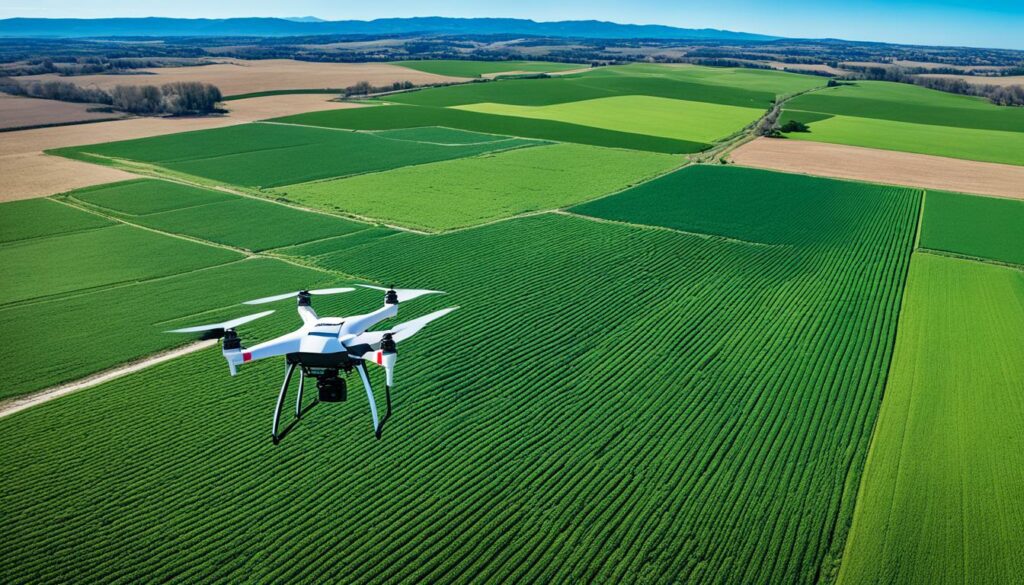
AI plays a key part in making farming safer. It checks things all the time and can predict problems before they happen. Machines with AI can look after themselves, making the whole farm safer for people working there.
For example, smart machines can tell when they’re about to break. They can even check on the plants and advise on fixing them fast. This means less chance of accidents on the farm.
AI also helps farmers to manage risks better. It looks at things like the weather, the soil, and what the market needs. Then, it helps farmers make choices that are less risky.
It also helps farms use their resources better. This means less waste and more food from the same land. By spotting and fighting off things that can harm the crops, AI protects the farmers’ work and keeps the food coming.
To wrap up, AI is making farming safer and less risky. It’s changing farming for the better, preparing it for a bigger, more sustainable future. This technology isn’t just about keeping up with more mouths to feed. It’s about farming smarter and safer for everyone.
Agricultural technology is growing fast thanks to AI-powered sensors. These sensors help farmers make better decisions. They give accurate and useful data.
In farming, there are many smart sensors. They watch over different parts of the farm. Soil moisture sensors tell when to water. Weather sensors forecast the weather.
Pathogen detectors find diseases early. This helps stop big crop losses. Nano sensors can check soil and plant health very accurately.
Sensor data analysis is key in farming today. AI tools let farmers watch things in real time. They can track crop growth, soil health, and pest movement.
With this data, AI systems can give tips. For example, they can say the best time to harvest. Or they can figure out what nutrients crops need. This helps make farming more sustainable and profitable.
| Sensor Type | Function | Benefits |
|---|---|---|
| Soil Moisture Sensors | Monitor soil water levels | Optimize irrigation, conserve water |
| Weather Sensors | Predict weather conditions | Plan farming activities, minimize risks |
| Pathogen Detection Sensors | Identify crop diseases early | Prevent wide-scale crop damage |
| Nano-based Sensors | Monitor soil and plant health | Ensure precise nutrient management |
With AI farm monitoring, farmers can use smart insights. This leads to more productive and sustainable farms. It opens the door to a smarter future in agriculture.
The way drones in agriculture are used is changing farming. They give farmers new ways to look after their crops. The use of these technologies is on the rise, with the market expected to reach $4.8 billion by 2024.
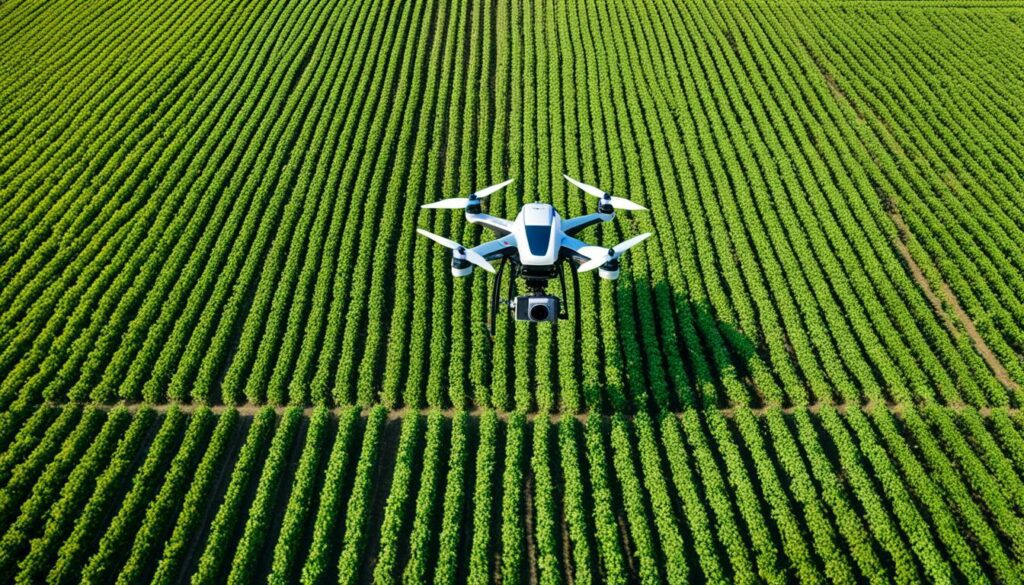
The use of AI drone technology for precision farming can increase crop yields by up to 5%. For example, South Korea uses drones for 30% of their crop spraying. This not only boosts work rate but also cuts down on physical effort for farmers.
With just ten drones, two workers can plant 400,000 trees daily. In Australia, drones are being studied for better irrigation methods. This shows how drones can help in different areas of farming.
In countries like the Netherlands and Japan, self-pollinating drones are in the works. The drones could help lessen the need for humans in farming. The work from the University of Tokyo shows they can increase crop production.
Also, drones with special software can predict how plants, like broccoli, will grow. They know the condition of each plant in the field. This means less guesswork for farmers and lower costs for hiring extra help.
| Function | Capability |
|---|---|
| Spraying | 30% of agriculture spraying in South Korea |
| Tree planting | Two operators and ten drones can plant 400,000 trees daily |
| Irrigation | Research in Australia for efficient solutions |
| Pollination | Development in the Netherlands and Japan |
| Data Analysis | Trillions of pixels collected, low-cost drones predicting plant growth |
Farm robotics and AI technology in drones need to get better. They need to learn about more types of crops and planting styles. But already, they’re making a big difference in farming. They help cut food loss and increase income for farmers. Harvesting at the right time is crucial. Waiting just one day can lower the income potential by over 20%.
AI technology has changed how we look after animals on farms. It watches over their health, food, and where they live closely. This helps animals be healthy and farms to work better.
AI tools with high-tech sensors keep a close eye on animals. They see how they eat, drink, and move very clearly. This makes sure animals are well looked after. Vision AI even spots if an animal doesn’t feel well early. This helps without needing a person there all the time.
AI also joins forces with IoT devices for smart farming. This makes management much better. For instance, special AI tools help in creating precise data about animals. This makes looking after them more efficient, saving time and improving accuracy.
Detecting diseases early is a big benefit of AI in farming. AI sees problems like sickness or injuries very soon. It looks at how animals stand or move, and even at their droppings. This early warning helps prevent diseases from spreading.
AI also checks on the animals’ weight in real-time, which can show if they’re not well. This is like having a doctor always keeping an eye on them. It makes sure they get sick less often.
Using AI helps farms make food in a better way, considering things like climate change. This way of farming is called Precision Livestock Farming. It makes food production more efficient and less harmful to the environment. It also helps manage feeding and living for the animals in the best way. This all leads to more food, better quality, and less waste.
Remote monitoring systems have changed agriculture for the better. They let farmers gather data in real time, anytime. This [remote monitoring system](https://sensights.ai/remote-monitoring-systems/) improves how decisions are made, offering important insights exactly when needed. For farms far from towns, these systems are a game-changer, helping with tough challenges.
Being able to send alerts instantly is a big deal for these systems. They warn about tech problems or emergencies fast, so farmers can act quickly. Advanced data analysis makes it easier to spot patterns and fine-tune farm work.
Isolated farms really benefit from these systems. They get info in real time, helping to deal with any issues – like machines breaking or sudden weather changes. And all the data is stored safely online. This makes it easy to look at, understand, and use.
These systems work on lots of devices, like phones and computers. This makes running the farm smoother and saves money. It also makes farms a safer place to work.
“Remote monitoring ensures compliance with environmental regulations and optimises resource usage, reducing the environmental footprint of industries.”
To wrap up, these monitoring systems are a must for isolated farms. They make work more efficient and meet these farms’ special needs perfectly, showing their value in today’s farming world.
In agriculture, AI for predictive maintenance is changing how we care for machinery. It addresses the huge cost of machine downtime, which causes about $647 billion of losses each year. This tech brings big advantages for farming, showing why its use should grow.
Predictive maintenance helps by catching failures before they hit hard. AI systems watch over machinery all the time. They use different data to foresee breakdowns. For example, UptimeAI’s tech cuts down false alarms by up to 500%, as they say in their reports. This is a big deal, saving both time and money, and machinery becomes more reliable.
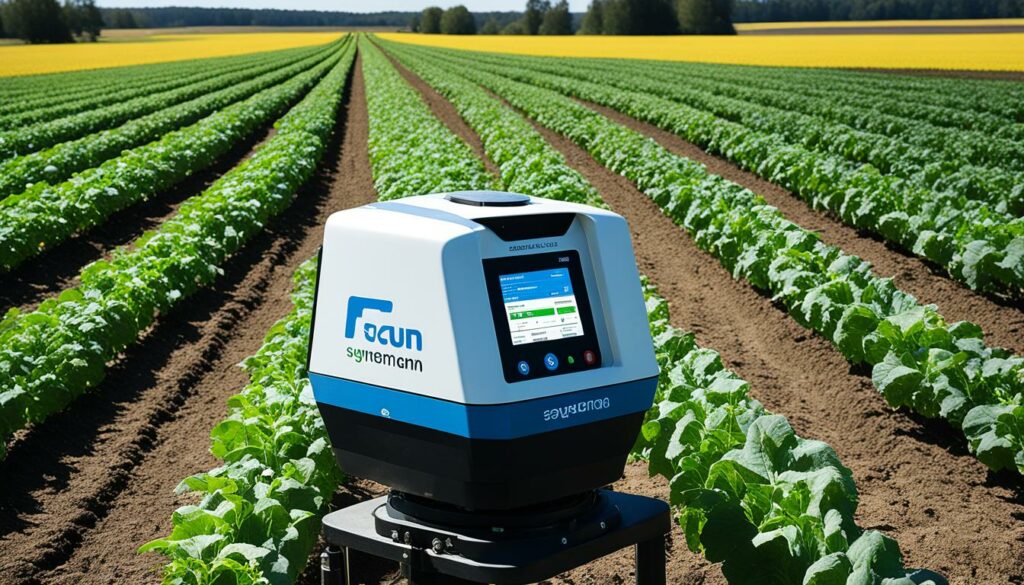
Keeping agricultural equipment in good shape is key for high output. With AI in farm management, farmers keep their machines healthy. This avoids sudden stops. UptimeAI’s tool works with over 100 types of equipment. It helps find out breakdown reasons and advises on fixes. It’s very handy for equipment maintenance on farms.
Using these AI systems brings big money savings. The McKinsey Global Institute believes between $240 and $630 billion in savings is possible by 2025, for manufacturers, thanks to predictive maintenance. This shows clearly how vital AI’s role is. It makes agriculture more efficient and less costly.
Exploring AI success stories in farming shows how tech is changing agriculture. Blue River Technology’s See & Spray had over 90% weed-killing accuracy. This cut down herbicide use and farming’s harm to the environment.
DJI’s farming drones are another great example. They make watching and treating crops faster and save up to half the time and resources. Farm efficiency greatly increases with such AI tools.
| Technology | Application | Result |
|---|---|---|
| Blue River Technology’s See & Spray | Weed Identification and Elimination | 90% Accuracy, Reduced Herbicide Usage |
| DJI Drones | Crop Monitoring and Treatment | 50% Time & Resource Saving |
| CropIn | Predicting Crop Yields | 85% Accuracy |
| IBM’s Food Trust | Supply Chain Management | 80% Alignment with Market Demand |
From these cases, we learn that AI can do a lot for farming. Motorleaf’s AI systems in greenhouses upped crop yields by 30% and saved 20% energy. Plants are also safer from bugs and diseases with solutions like the Plantix app, which is over 80% accurate.
These examples show why AI should be part of farming. It boosts farm output and sustainability, cuts costs, and gets farmers closer to what consumers want. Agribora’s prediction tools, for instance, have raised profits by 25%.
Looking at AI success stories in farming and lessons from AI implementation gives us hope for better farming with technology.
AI has the power to change agriculture, but it faces hurdles in being widely used. The high cost of AI and its inaccessibility for small farms are major issues. Also, concerns about data safety are big as more farms use AI. This is to make their work more efficient.
Big costs stop many small farmers from using AI. Although it now works much faster than before, the cost is still high. This can lead to a gap between farms that can afford AI and those that can’t.
Digital farming lets us collect field data all the time. But, this leads to lots of data that needs expensive tools to understand. Robots can help do work, but they are not cheap either.
Keeping farm data safe is now a big challenge. With AI tech, farming depends a lot on data. But, this data can face many dangers as farming changes every day. So, making sure this data is safe is very important for farmers.
A project by IBM in 2011 showed why it’s critical to protect farm data. More AI tech in farming means more need for data safety. Farmers must both enjoy AI’s benefits and protect their data well.
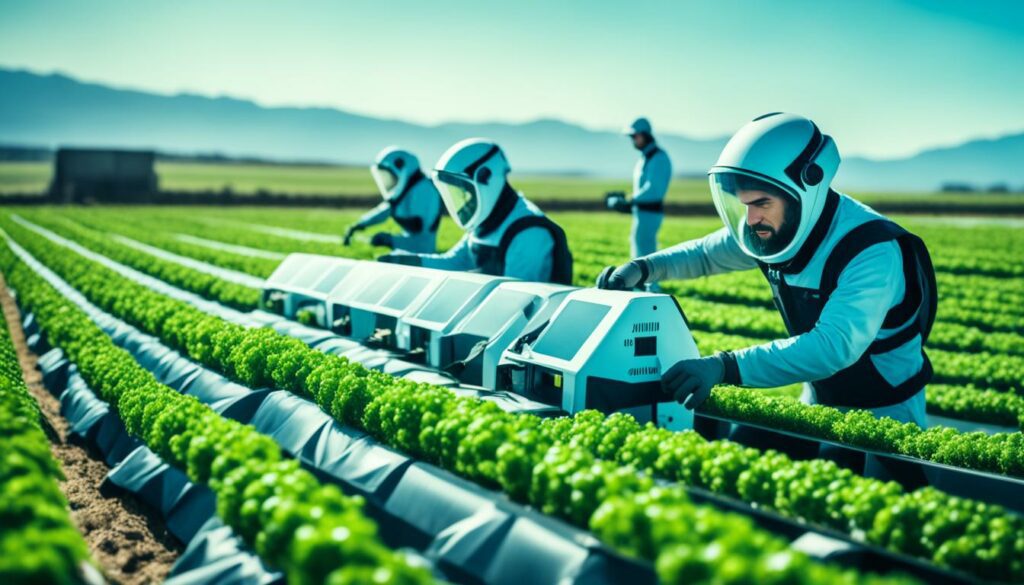
Solving these challenges is key for AI to work well in farming. It means making AI easier to get and keeping farm data safe. These steps can lead to better, greener farming for all.
| Aspect | Challenge | Solution |
|---|---|---|
| Cost | High implementation costs for small-scale farmers | Provide subsidies and financial support |
| Accessibility | Limited access to advanced AI technologies | Invest in affordable AI solutions for smaller farms |
| Data Security | Risks of data breaches and privacy violations | Implement stringent data protection measures |
| Statistical Quantification | Challenges due to ever-changing field conditions | Develop adaptive and resilient AI models |
| Creative Thinking | AI cannot fully replace farmers’ intuition | Combine AI insights with farmers’ expertise |
Getting the government and institutions’ support is crucial for AI in farming. They provide money for research, make rules for using AI right, and fund ethical AI work. The U.S. Department of Agriculture’s National Institute of Food and Agriculture (USDA-NIFA) and the U.S. National Science Foundation (NSF) help a lot.
The government has put a lot of money into developing AI for farming. For example, USDA-NIFA and NSF gave $220 million to 11 new AI research centres. Each centre gets about $20 million for five years and focuses on different AI fields.
The USDA-NIFA Institute at Washington State University uses AI to help farmers make better decisions. The USDA-NIFA AI Institute at Iowa State University creates digital twins to study plants like never before.
Having good rules for AI in farming is very important. These rules make sure AI is used in a fair way and helps everyone in farming. The AI Institutes, led by places like Georgia Tech and The Ohio State University, work on making AI fair and available to all.
| Institute | Focus Area | Leading University |
|---|---|---|
| NSF AI Institute for Advances in Optimization | AI and mathematical optimisation | Georgia Tech |
| NSF AI Institute for Learning-Enabled Optimization at Scale | Optimisation for semiconductor chip design, robotics, networks | University of California San Diego |
| NSF AI Institute for Intelligent Cyberinfrastructure with Computational Learning in the Environment | Making AI accessible for scientists | The Ohio State University |
| NSF AI Institute for Future Edge Networks and Distributed Intelligence | Efficient, reliable edge networks | The Ohio State University |
These actions show how much they want to use fund AI for farming better while following good AI rules. Both governments and schools are working really hard to make AI in farming more innovative.
The future outlook for AI in farming shines with promise. By 2050, the world will support around 10 billion people. This requires new solutions to boost farm products and protect our environment. AI in farming is poised for major growth, with the market set to increase from USD 1.7 billion in 2023 to USD 4.7 billion by 2028.
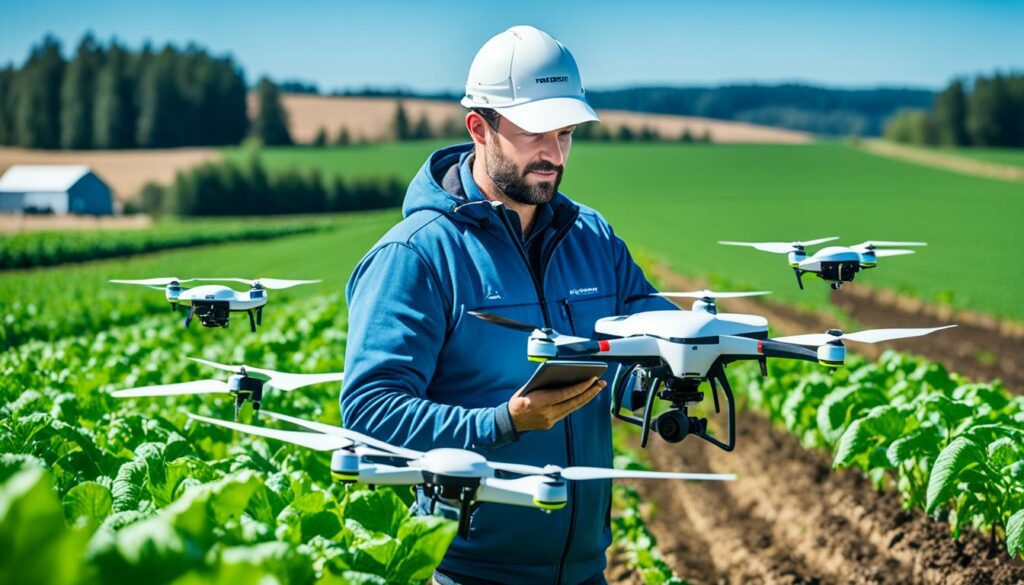
Several AI advances are driving this growth in farm tech. AI can spot apple black rot with more than 90% accuracy. Startups like CattleEye are using AI and ML to oversee cattle health from afar, leading to better milk.
AI drones are changing how we spread pesticides, making it smarter and more precise. Algorithms are also crunching huge amounts of data to tell us how much crops could yield on different soil types. This fine-tunes how we use our resources. Given that farming has a huge water demand but only 12% of land is good for it, these technologies are crucial.
AI is also making farming cleaner. The sector contributes to nearly a quarter of the world’s greenhouse gases. But, AI is helping to fight pests and diseases more effectively. For example, Trapview has boosted crop and quality by 5%, saving millions of euros. This shows how AI can make farming both greener and more profitable.
As we aim for greener farming, technologies like AI sensors and robotic farmers are growing. These help with everything from watching over soil to doing tedious tasks. Cutting-edge AI models and deep learning tech are key. They help us plan better for the challenges of feeding nearly 10 billion in the future.
In summary, AI has bright prospects in farming. Following AI farming trends and supporting tech growth are crucial steps. They help meet the food needs of our growing world. And they do this by farming in ways that are good for the planet.
Integrating AI with precision farming is changing the way we farm. It brings together advanced tech and data to make farming smart and efficient. This revolution highlights how using AI in farming can up crop harvests and save our resources.
AI in farming gives farmers high-tech tools to check and understand the soil, water, and crops. It collects and analyses data on the spot, giving farmers very precise info. Thanks to this, they can make decisions based on facts. These include things like the best time to plant, by looking at both current and past data, to get the most crops.
In resource-efficient agriculture, the aim is to use less water, fertilisers, and pesticides. AI helps through Variable Rate Technology. It tailors where and how much of these we use in the fields. This saves on resources and helps the environment too.
Let’s see how AI compares to traditional ways in using resources:
| Aspect | Traditional Methods | AI Optimised Farming |
|---|---|---|
| Water Usage | High | Reduced by up to 40% |
| Fertiliser Application | Uniform Across Fields | Optimised Using VRT |
| Pesticide Use | Excessive Usage | Targeted Interventions |
| Labour Costs | High | Reduced |
AI doesn’t stop there. It helps farmers decide when to plant, flies drones over fields to spot issues, and runs machines to sow seeds or spray crops. This boosts farm work quality while saving nature’s goods. Using AI alongside precise farming is crucial for a sustainable and fruitful agriculture future.
The future of farming is closely linked to technology. AI is key in this growth. But, it’s vital to think about ethics. This ensures the use of AI is fair and right. Transparency and accountability are very important.
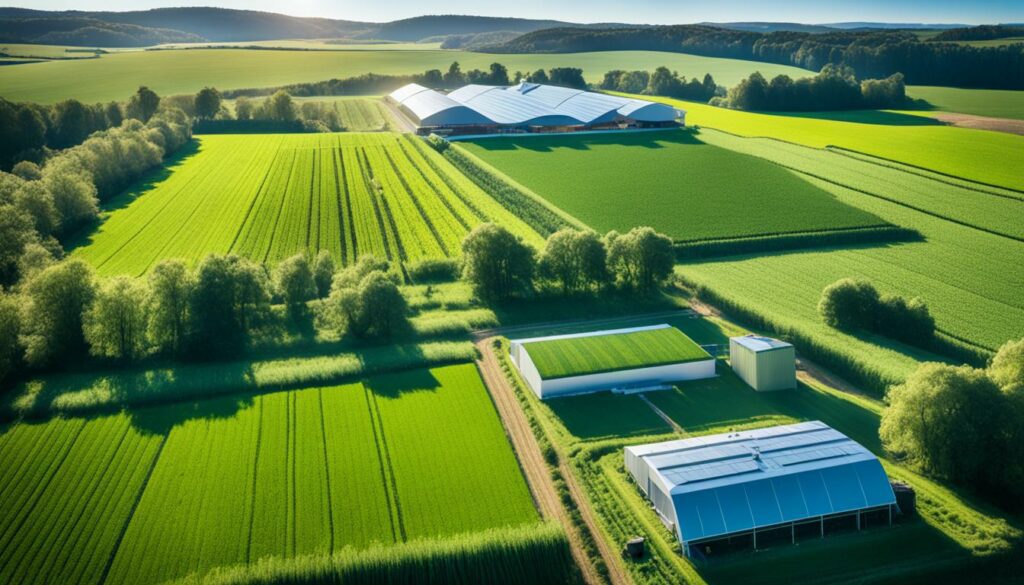
Being clear about AI is more than just a catchy phrase. It helps build trust between farmers and tech companies. Data collection from various sources like sensors and drones is essential for AI in agriculture. However, some farmers worry about their privacy because of this. Having clear rules on how data is used is crucial for everyone to trust the system.
Accountability is critical when AI makes a mistake. It could be a wrong formula leading to a big loss, for example. To prevent this, strong encryption and cyber-safety steps should protect farmers’ data. Also, methods exist to make data anonymous. This keeps it useful while protecting privacy.
AI’s use can change how we monitor animals. It’s important that these changes don’t harm them. Guidelines should be in place to protect animal well-being. Addressing job losses is also a big concern. Training and new job creation are needed to support those impacted by automation, like small farmers and rural workers.
| AI Consideration | Impact | Recommendation |
|---|---|---|
| Transparency | Builds trust, mitigates concerns | Implement clear guidelines |
| Accountability | Addresses errors, ensures security | Employ anonymisation techniques |
| Animal Welfare | Prevents stress, discomfort | Enforce ethical guidelines |
| Job Displacement | Impact on rural communities | Reskilling programs |
| Data Ownership | Privacy concerns | Comprehensive data policies |
Integrating ethical AI in farming needs a full, fair approach. It ensures everyone benefits from AI. Using transparent and accountable frameworks is crucial. It helps AI work for everyone in a good way.
In agriculture, the talk about AI stirs up many ideas from farmers. They look at AI in varied ways. They see the benefits but also the challenges of using high-tech in farming.
Many farmers are slow to embrace AI. They worry it might change their way of farming too much. This fear is driven by concerns about the cost, their privacy, and the loss of their traditional methods.
In Ohio, the Farm Bureau and Nationwide worked together. They wanted to help farmers think carefully before jumping into new technology. Their advice underlines the importance of careful planning and a clear view of AI’s role in farming.
Despite some farmers being unsure, AI is making its way into fields. In places like the Commodity Classic in Houston, farmers are keen to see the latest tech. There, they can learn about software and machines that help crops stay healthy.
Now, we have software that keeps an eye on crops all the time. It spots problems early, like diseases and bugs. And with machines that steer themselves, farming is becoming more high-tech than ever.
| Advancements | Impacts |
|---|---|
| AI-powered Disease Prediction Models | Forecast and Early Intervention for Crop Diseases |
| Precision Farming Tools | Optimise Crop Management and Resource Usage |
| AI Algorithms in Drones | Detection of Crop Stress and Disease Symptoms |
The farm world is changing fast. And with AI in the mix, farming is getting a big boost. The key is to handle changes calmly, ensuring everyone wins from new technologies. This way, AI is becoming more and more common in fields everywhere.
AI in farming leads to big changes in agriculture. It brings together new tech with old ways to make farming safer and more efficient. The use of AI in monitoring farm safety is a big step. It protects farms day and night. This helps save money on workers and keeps the farm safe from harm.
The change AI brings goes deeper than just safety. It helps look after animals and crops better. By watching the animals and plants closely, it stops diseases early. This means the farm runs smoother and the crops grow better.
With AI, farmers can spot problems with their crops before they get bad. They can care for the land in a smarter way. This new approach helps save money and time by using robots and drones that work in the fields. These machines watch for pests and help grow better crops without needing as much manual work.
AI is not just about fancy tech. It’s key for us to feed a growing world while protecting the environment. Everyone, from farmers to tech experts to policymakers, needs to work together. In doing so, we can ensure that AI in agriculture makes the future better for everyone. This is an exciting time, as new tech changes how we farm for the good of the planet and people.
AI in farm safety means using smart tech to meet safety rules and lower risks. It keeps an eye on the farm all the time. This stops mishaps and makes working safer.
Farming has changed big time from hard work to using AI. This change makes farm work better for our Earth and for us.
There are special sensors for finding germs, checking if the soil is wet enough and seeing how well crops are doing. They give farmers smart data to make better choices.
Drones and robots help with land checks, keeping an eye on plants, and even collecting crops. They make farming more efficient with their new technology.
AI looks after animals’ health and feelings better. It can spot sickness and stress early, so animals get the help they need fast.
Systems that watch the farm from afar, with AI, can alert farmers about problems in real time. This is great for farms far away, helping to fix issues quickly.
Predictive maintenance means fixing things before they break using AI. It keeps the farm running smooth and stops expensive stops in work.
Looking at cases where AI worked well shows us how to use it better. We learn what works, what doesn’t, and how to get the most out of AI in farming.
The cost and access to AI is tricky, especially for small farms. Keeping data safe and private is also a big issue that needs to be sorted.
Support can come from giving money for new tech and making rules that are fair. It’s about using AI right while looking after everyone’s needs.
The future with AI looks bright, making farms more effective, growing more food, and helping the planet. It’s needed to feed everyone as the world grows.
Using AI smartly in farming makes more crops with less waste. This saves land and water in a clever way, making farms do better.
Making sure AI is fair and follows good rules is key. We must set clear guidelines to stop bad use and to share AI’s help equally.
Farmers think different about AI. Some are unsure because it’s new, but many see the good it can bring. They think it can make farming better and last longer.